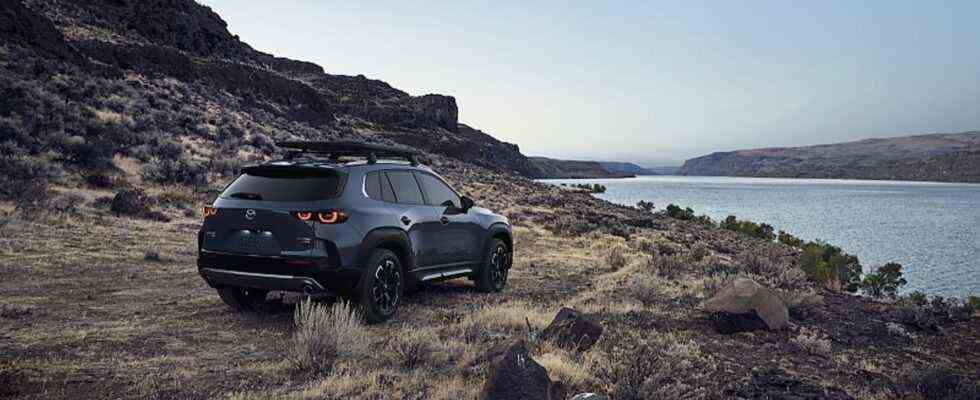Mazda wants to go to the premium camp
Against the trend
Mazda CX-50 USA
© press-inform – the press office
Mazda has often gone its own way – this time too. While more and more manufacturers are completely saying goodbye to the world of combustion engines, the Japanese are not only relying on electric drives and hybrids, but also on new gasoline and diesel engines. By the way, you want to move up to the premium league.
Even if crossovers like Mazda CX-3 or CX-5 have been earning the most money for years and models like the MX-30 have only been hesitant to squint into the electrical world, the core of the brand is still the MX-5. Over the years – despite some ups and downs – it has hardly lost anything of its fascination over the various generations. Open, puristic, light and with a manageable engine power, the two-seater has been attracting customers largely unchanged since 1989, more or less worldwide. When it comes to the major automotive electric trend, Mazda is comparatively cautious. The increasing influence of Toyota as a result of the growing cooperation does little to change this. Although the Mazda 2 is now also available as a part-time electrician as a twin model of the Toyota Yaris Hybrid, a major shift towards electromobility looks different. The Toyota Yaris Hybrid with the Mazda logo on the radiator grille combines a 68 kW / 93 hp 1.5-liter three-cylinder petrol engine with a 59 kW / 80 hp electric motor. The system output of 85 kW / 116 PS ensures a top speed of 175 km / h and a standard consumption of 3.8 liters. However, the Mazda 2 Hybrid cannot be charged at the socket.
Instead of indulging in monotechnology in individual models or even with the drive, Mazda wants to grow upwards and catch up with the premium league with its new models. Even if brands like Audi, BMW or Mercedes hardly appear tangible at the first jump, things look different with Alfa Romeo, Volvo or Cadillac. This should be made possible by a new platform that the technology-loving Japanese have developed over the past few years with great dedication and inventive talent. Unlike many of the competitors in the volume segment, this is a platform for larger vehicles with rear-wheel drive and the corresponding all-wheel drive option. The platform does not rely on electric drives, but rather combustion engines with four and, in particular, six cylinders, which can be hybridized on request.
The latest group model with the name CX-50 is not yet based on the new platform, but is intended solely for the North American market and is optionally available as a front or all-wheel drive. The Mazda CX-50 is the first vehicle that has recently been produced in the new plant in Huntsville, Alabama, which was built jointly with Toyota. The new European models Mazda CX-60 and CX-80 will switch to the new platform with rear-wheel / all-wheel drive and longitudinal engines in the coming year. In the US and some other non-European markets, the Japanese are introducing the new Mazda CX-70 and Mazda CX-90 models based on the same platform, which are slightly larger and wider than the European variants.
While the Mazda CX-60 will have two rows of five seats from mid-2022, the larger Mazda CX-80 will offer up to seven seats in three rows from 2023. The two SUVs are the first vehicles with the new plug-in hybrid drive as an inline four-cylinder, which is supported by an electric motor. In addition to this drive, the newly developed in-line six-cylinder engines are also finding their way into the new models – as petrol and diesel. Somewhat surprising: only in the USA will there be a turbo-charged version of the new in-line six-cylinder petrol engine in addition to the plug-in hybrid drive. In Europe there is the order: four-cylinder PHEV, six-cylinder diesel and only then a six-cylinder gasoline engine – again without supercharging. Instead, the current models have an SPCCI drive that combines the advantages of gasoline and diesel in one engine.
In addition, Mazda will offer a new variant of the Mazda MX-30 in Europe and the USA in the first half of 2022. The electric crossover is then also available in a version with a rotary piston engine that drives a generator for on-board power generation. The innovative plug-in hybrid drive, which always drives the wheels electrically, enables purely electric driving over shorter distances as well as covering longer distances with the rotary piston engine. It won’t be until 2025 that Mazda will unleash a range of new electric vehicles on customers around the world. By 2030 there should only be fully electric vehicles and hybrid versions in the European model range. And not only then do you want to be in the premium league.


